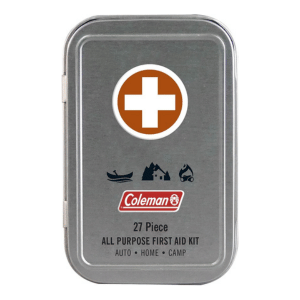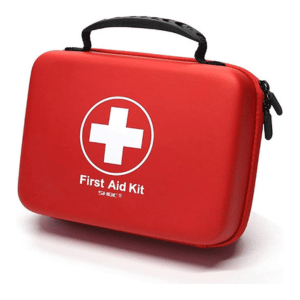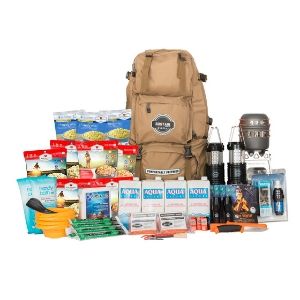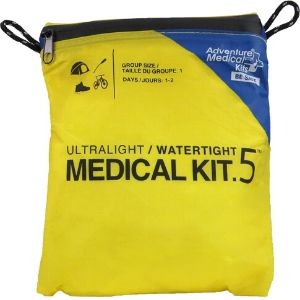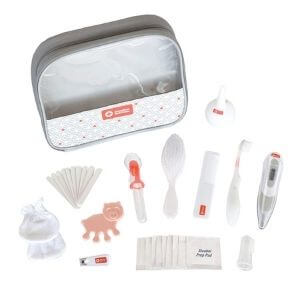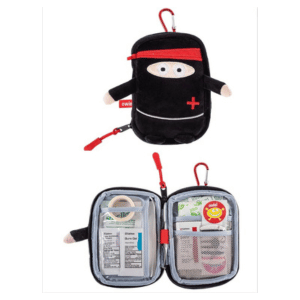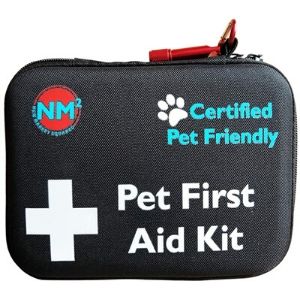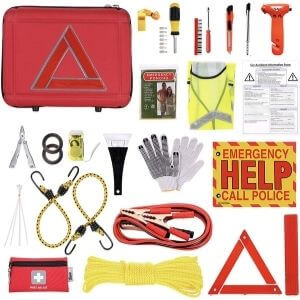Reviewed by health expert Sally Russell, MN, CMSRN, CNE
8 Best Pre-Made First Aid Kits & How to Choose One
SafeWise experts have years of firsthand experience testing the products we recommend. Learn how we test and review.
Emergencies and accidents are a common part of life. It's best to be prepared. One of the biggest perks of a pre-made first aid kit is not having to remember where everything is during an emergency.
But choosing a first aid kit isn’t always simple. Grocery stores and pharmacies have several options, but the clerk may not know you well enough to recommend the best first aid kit for your lifestyle. We researched the best pre-made first aid kits and how to pick one for your needs, no matter if you're the outdoors type, road tripper, parent or pet lover.
This guide will illuminate your personal first aid kit needs and share our top recommendations. You might also like our best fire safety emergency kits and best car emergency kits.
By signing up, you agree to our Terms and Conditions and Privacy Policy.
Choose a first aid kit that fits your unique needs
No matter your needs, there's a pre-made first aid kit on the market that will serve you well. If you're a parent of a newborn, for example, you need a kit fitted to an infant’s needs. It would include items to treat croup, earaches, tummy aches, and teething symptoms. If you have pets, you want an entirely different first aid kit with products to remove ticks and treat sore paws.
Hikers and campers have different medical requirements. You spend your time in rugged terrain, which increases your risk of falls and sprains. And if you travel in groups, you may need to purchase a larger first aid kit. For solo adventurers, a smaller, lightweight kit could serve you best.
If you regularly commute or take road trips, getting a car first aid kit containing flares, jumper cables, water, and food is smart. Those who live in areas with snowy weather should add a blanket and other winter safety items to the kit.
8 best pre-made first aid kits
Our best first aid kit recommendations fit a variety of lifestyles, so you’re sure to find one—or a couple—that will help you soothe ouchies for every member of the crew (furry ones included!).
1. Coleman All Purpose Mini First Aid Kit
*Amazon.com price as of post date. Offers and availability may vary by location and are subject to change. Read full disclaimer.
If the Coleman brand makes you think of heavy-duty water jugs and coffee thermoses, you’re on the right track. This Coleman All Purpose Mini First Aid Kit is designed for spaces with limited storage, like in the car or diaper bag.
Though it's only as big as a tin of breath mints, it holds 27 first aid items like latex-free bandages, antibiotic ointment and antiseptic wipes, plus items that are helpful when out and about, like safety pins, sting relief wipes, and a razor blade. (We recommend getting rid of the razor blade if you have small kids.) We also like that it has a hard case to protect the goodies inside.
2. SHBC Waterproof First Aid Kit
*Amazon.com price as of post date. Offers and availability may vary by location and are subject to change. Read full disclaimer.
The SHBC Waterproof First Aid Kit contains almost any bandage imaginable. It has more than 228 items total, including survival items like a multi-function saber card, a whistle, scissors, tweezers, first aid blankets and manuals. And since it's small (8.7”×6.7”×3.2”) and waterproof, it's perfect to take camping, boating, or hiking.
Even better, it's inexpensive, so you can put a few around the house, one in the car, and in your camping or hiking gear, so they're handy.
New product alert!
We just discovered the KeepGoing travel first aid kits that come in a variety of fun patterns to turn "owie" time into "wowie" time. We like that these don't look clinical, which can help ease little ones' fears while you bandage up scrapes and scratches.
3. Sustain Supply Co. 4-Person Emergency Survival Kit
*Amazon.com price as of post date. Offers and availability may vary by location and are subject to change. Read full disclaimer.
If you live in a disaster-prone region, you’ll want to buy the Sustain Supply Co. 4-Person Emergency Survival Kit. Sure it's expensive, but it's worth it. It features all the supplies needed for four people to survive for three days, as well as a number of first aid items. All of this goes into a backpack so it's easy to carry.
4. Adventure Medical Kits Ultralight and Watertight Medical Kit
*Amazon.com price as of post date. Offers and availability may vary by location and are subject to change. Read full disclaimer.
The Adventure Medical Kit first aid kit caters to the lone ranger. It comes in three sizes so that you can find the one that fits your needs. Plus, it has three water-proof barriers to keep things dry, even when you're kayaking.
5. The First Years American Red Cross Baby Healthcare Kit
*Amazon.com price as of post date. Offers and availability may vary by location and are subject to change. Read full disclaimer.
If you have a kid, you’ll wonder how you ever left home without The First Years American Red Cross Baby Healthcare Kit. It meets every requirement for a young child who’s not feeling well, plus some. The kit has a thermometer, medicine spoon, nasal aspirator, and more for taking care of tots. It's small so you can toss it in the diaper bag before heading out.
6. Owie Ninja First Aid Kit
*Amazon.com price as of post date. Offers and availability may vary by location and are subject to change. Read full disclaimer.
The Owie Ninja will make your kid smile while you take care of a boo-boo. The plush little ninja includes gauze pads, burn cream, bandages, triple antibiotic ointment, sting relief, Hydrocortisone pads and even fun stickers for your brave patient. We love that it comes with a carabineer so that it can be hooked to the diaper bag, stroller or a beach bag.
7. New Market Squared Pet First Aid Kit for Dogs & Cats
*Amazon.com price as of post date. Offers and availability may vary by location and are subject to change. Read full disclaimer.
This one's for the pet parents. If you own a kitten or a dog that likes to chew everything in sight—even sharp objects—purchase the New Market Squared Pet First Aid Kit for Dogs & Cats. It holds 45 items essential to handling a pet emergency. The included emergency care handbook can guide you through some stressful situations.
8. Thrive Car Emergency Kit
*Amazon.com price as of post date. Offers and availability may vary by location and are subject to change. Read full disclaimer.
Keep this kit in the car. The Thrive Car Emergency Kit doesn’t have the most first aid items, but it's well-equipped with car emergency supplies. It includes bungee cords, tools, rope, jumper cables, and more to get you out of many different emergency situations.
*SafeWise has conducted impartial research to recommend products. This is not a guarantee. Each individual's unique needs should be considered when deciding on chosen products.
Focus on the essentials when building a first aid kit
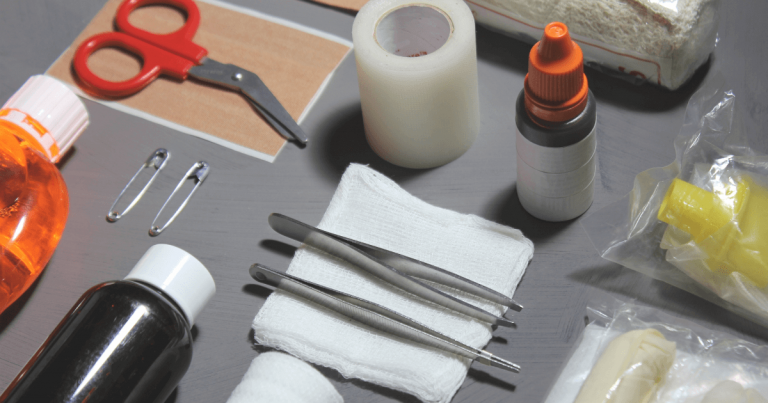
When evaluating or making a first aid kit, focus on the essentials. The following list isn’t exhaustive, but it covers many of the basic products found in first aid kits. If your kit is missing any of these must-haves, be sure to add them separately.
- Splints or wraps
- Gauze pad packs
- Medical tape
- Bandages (adhesive bandages, triangular bandage, etc.)
- Rubbing alcohol
- Antibiotic ointment or antiseptic wipes
- Tweezers
- Aspirin
- Scissors
There are some optional items you may want to consider too:
- Insect bite cream
- Medical tape
- CPR mask
- Cold pack
- Hand sanitizer
- Nitrile gloves
- Emergency blanket
How to safely use first aid products
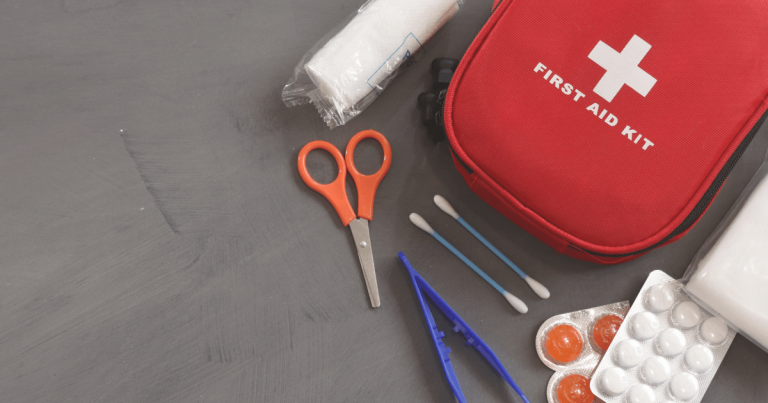
Each item in a first aid kit comes with guidelines for use. Read these to prevent allergic reactions and other maladies. Many first aid kits also come with an instruction book or recommend attending a first aid class.
Reading the book and attending the class are excellent ideas, but if you face an emergency before you do this, use the five tips below. They can help you take immediate action and keep everyone safe.
- Keep the kit in a central location. Keep your first aid kit in an easy-to-access and known location—for adults, not kids—within your home or vehicle.
- Examine the active ingredients. Some drugs react poorly with other medications or contain ingredients that could cause a rash. Make sure your products, such as aspirin, are safe for use.
- Look for indications of use. Every medication, ice pack, and other first aid item includes indications for use. Follow them to ensure a bandage doesn’t stick to a wound.
- Follow the directions. Kids under age twelve usually require smaller doses of medications. Read the directions carefully so you don’t over-medicate.
- Remember the expiration dates. Antibiotic cream and other first aid items come with expiration dates. Typically, they lose effectiveness after this date, so make sure you’re aware of when to replace these products. This is particularly important if you're storing prescription medications. Nitro (for someone with heart disease), for example, should be replaced every six months because it degrades and won't work as well.
- Keep it cool. Some medications, like insulin, need to be kept cool. If you're storing your emergency kit in the garage or in the trunk of your car, there might be an issue.
- Don't use vaseline or antibiotic ointment for burns. It can trap the heat in and continue the burn if the burn is new and intense. Aloe is best.
- Nix the aspirin for kids. It's not recommended that young children (infants through school-age) take aspirin, especially if you don't know if they've recently had a viral illness. Children taking aspirin can develop Reyes syndrome, which can be fatal.
Related articles on SafeWise
Disclaimer
Product prices and availability are accurate as of the date/time indicated and are subject to change. Any price and availability information displayed on Amazon at the time of purchase will apply to the purchase of this product. Safewise.com utilizes paid Amazon links.
Certain content that appears on this site comes from Amazon. This content is provided “as is” and is subject to change or removal at any time.
Recent Articles




